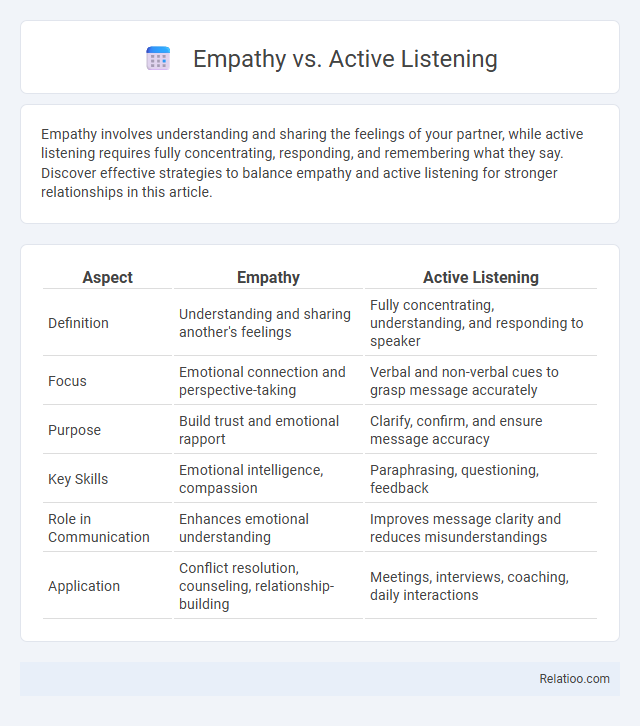Empathy involves understanding and sharing the feelings of your partner, while active listening requires fully concentrating, responding, and remembering what they say. Discover effective strategies to balance empathy and active listening for stronger relationships in this article.
Table of Comparison
| Aspect | Empathy | Active Listening |
|---|---|---|
| Definition | Understanding and sharing another's feelings | Fully concentrating, understanding, and responding to speaker |
| Focus | Emotional connection and perspective-taking | Verbal and non-verbal cues to grasp message accurately |
| Purpose | Build trust and emotional rapport | Clarify, confirm, and ensure message accuracy |
| Key Skills | Emotional intelligence, compassion | Paraphrasing, questioning, feedback |
| Role in Communication | Enhances emotional understanding | Improves message clarity and reduces misunderstandings |
| Application | Conflict resolution, counseling, relationship-building | Meetings, interviews, coaching, daily interactions |
Understanding Empathy: Definition and Importance
Empathy involves recognizing and sharing the emotions of others, creating a deep emotional connection that fosters trust and compassion. It is distinct from active listening, which focuses on attentively hearing and processing spoken words to fully understand the speaker's message. Understanding empathy is crucial in personal and professional relationships as it enhances communication, reduces conflicts, and promotes emotional support.
What is Active Listening? Key Elements Explained
Active listening involves fully concentrating, understanding, and responding thoughtfully to the speaker, which distinguishes it from general empathy that is about feeling another's emotions. Key elements include giving your undivided attention, providing feedback through paraphrasing or summarizing, and withholding judgment to ensure clarity and mutual respect. By mastering active listening, you enhance communication effectiveness and foster stronger interpersonal connections.
Empathy vs Active Listening: Core Differences
Empathy involves understanding and sharing another person's feelings on a deep emotional level, fostering connection and compassion. Active listening, by contrast, emphasizes fully concentrating, understanding, and responding thoughtfully to the speaker's words without judgment or interruption. The core difference lies in empathy's emotional engagement versus active listening's focused attention and verbal feedback during communication.
The Role of Empathy in Effective Communication
Empathy plays a crucial role in effective communication by enabling individuals to genuinely understand and share the feelings of others, creating a foundation of trust and emotional connection. Active listening complements empathy by requiring focused attention and feedback, ensuring that the speaker feels heard and validated. Together, empathy and active listening foster open dialogue, reduce misunderstandings, and enhance collaborative problem-solving in personal and professional interactions.
How Active Listening Enhances Conversation
Active listening significantly enhances conversations by fostering genuine understanding and building trust between participants. This technique involves fully concentrating, interpreting, and responding thoughtfully to the speaker, which reduces miscommunication and encourages openness. Unlike empathy alone, active listening actively engages both verbal and nonverbal cues, making dialogues more meaningful and effective.
Psychological Benefits of Practicing Empathy
Practicing empathy enhances your emotional intelligence by allowing deeper understanding and connection with others, leading to reduced stress and improved mental health. Unlike active listening, which emphasizes attentively hearing others, empathy involves sharing and resonating with their feelings, fostering compassion and social bonding. These psychological benefits include increased self-awareness, emotional regulation, and stronger interpersonal relationships.
Skills Required for Active Listening
Active listening requires focused attention, nonverbal cues recognition, and the ability to provide feedback that confirms understanding, making it a critical communication skill distinct from empathy. While empathy involves emotionally connecting with others' feelings, active listening demands cognitive engagement and patience to fully comprehend the speaker's message. Developing your active listening skills strengthens interpersonal relationships and enhances effective communication in both personal and professional settings.
Common Misconceptions about Empathy and Listening
Empathy is often mistaken for simply understanding another's feelings, but it involves genuinely sharing and connecting with their emotional experience, unlike active listening which focuses on fully concentrating, understanding, and responding thoughtfully to the speaker. Many assume active listening guarantees empathy, yet effective listening without emotional engagement lacks the depth of true empathy. Understanding these distinctions enhances your communication skills by ensuring you do not conflate empathetic connection with attentive listening, leading to more meaningful and supportive interactions.
Practical Tips to Improve Empathy and Active Listening
Improving empathy and active listening involves focusing on your ability to truly understand and connect with others' feelings and perspectives by maintaining eye contact, avoiding interruptions, and reflecting back what you hear. Practicing mindfulness enhances your presence during conversations, allowing you to notice both verbal and nonverbal cues, which deepens your empathetic response. Implement strategies like asking open-ended questions and summarizing key points to ensure clarity, building stronger relationships and fostering mutual trust.
Integrating Empathy and Active Listening in Daily Life
Integrating empathy and active listening in daily life enhances communication by fostering genuine understanding and emotional connection. Empathy involves recognizing and sharing others' feelings, while active listening requires fully concentrating, understanding, and responding thoughtfully to the speaker. Practicing both skills together improves relationships, reduces conflicts, and promotes a supportive environment in personal and professional interactions.

Infographic: Empathy vs Active Listening
 relatioo.com
relatioo.com